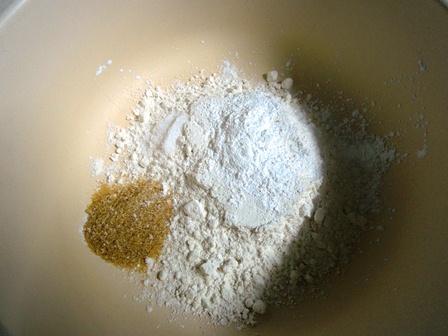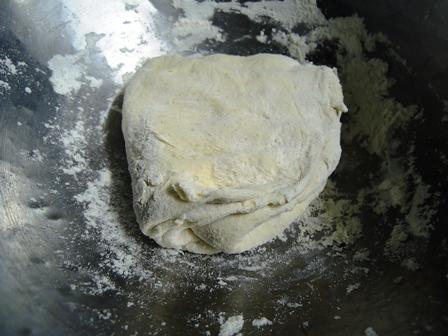Self raising flour or self rising flour bread
 Making homemade bread from self raising flour or self rising flour is quite tricky and many bakers will tell you it is impossible. After about one and a half years of experimenting making bread I finally figured it out. In my last article I showed a new technique, that I had developed, for making bread and I used this new method to make bread from self raising flour / self rising flour.
Making homemade bread from self raising flour or self rising flour is quite tricky and many bakers will tell you it is impossible. After about one and a half years of experimenting making bread I finally figured it out. In my last article I showed a new technique, that I had developed, for making bread and I used this new method to make bread from self raising flour / self rising flour.
The difficulty of making bread with self raising flour is that self raising flour has very low protein content. Technically or even legally, bread made from self raising flour would not be considered bread due to the low protein content. I tried to succeed at making bread from self-raising flour because I wanted to show how my new method of making bread, The Batter and Dough Method, works.
Differences between bread flour and self raising flour
Bread flour has about 12% to 14% protein content. Plain flour or All Purpose flour has about 10% to 12% protein content. Self raising flour or self rising flour has about 7% to 9% protein content. This is one of the basic reasons why traditional bread making techniques do not work with self-raising flour. In traditional bread making techniques one could spend a lot of time kneading the dough to get beautiful results. With the Batter and Dough Method you would require almost no kneading of the dough. That is, in traditional methods, kneading brings out more gluten out of the dough where as with the Batter and Dough Method the gluten is generated before making the dough. There was no known method of making bread from self-raising flour.
The self raising flour bread recipe
| Self Raising Flour Bread Recipe – New Method | ||||
| Item | Ingredients | Percentage | Weight | Weight |
| (%) | (g) | oz. | ||
| 1 | Self Raising Flour for Batter | 70 | 210.00 | 7.39 |
| 2 | Self Raising Flour for Dough | 30 | 90.00 | 3.17 |
| Subtotal | 100 | 300 | 10.56 | |
| Batter Stage | ||||
| 3 | Cold water | 45 | 135.00 | 4.75 |
| Dough Stage | ||||
| 4 | Salt | 1 | 3.00 | 0.11 |
| 5 | Sugar | 2.5 | 7.50 | 0.26 |
| 6 | Baking Powder | 3 | 9.00 | 0.32 |
I have divided the simple bread making process into two stages, the first is making the Batter for the self raising flour bread and the second is making the Dough for the self raising flour bread. Hence 70% of the flour and cold water are used to make the batter for the self raising flour bread. Then after four hours of soaking the self raising flour in water, the rest of the flour, salt, baking powder and sugar is added in. This is a self raising flour bread.
Photos of the self raising flour bread new method process

I had forgotten to take the picture of the self raising flour with water so I am using one taken from a previous experiment. This photo is just to give you a perspective of what it should look like. I must have carried out 7 experiments at least before I figured out how to make bread form self raising flour. It is tricky and full of pit falls. My dust bin is over flowing with failed experiments.

Do a gentle mix of the water and flour and leave it to rest for 4 hours. This period of rest will bring out most of the gluten. DO NOT MIX VIGOROUSLY and DO NOT KEEP COMING BACK TO MIX during the 4 hours of rest. Rest means REST. If you catch your itchy hands wanting to stir or mix the batter, slap your naughty hand with the good hand.
From all the experiments I had run, I realised that since self raising flour is of high starch content and low protein content any extra mixing will bring out the starch. Have you tried making mashed potatoes? When you mash the potatoes you have to do it gently. If you over mix or over mash the potatoes, too much starch is released and it becomes gummy and has a horrid taste. The same thing occurs with self raising flour and the resulting ‘bread’ will taste awful. For this reason I believe that, the Batter Bread Method which uses a mixer, will not produce breads as delicious as those produced by the Straight Dough Method, the Sponge and Dough Method and the Batter and Dough Method.
I have tried resting or soaking the flour for 30 minutes, 1 hour 20 minutes, 3 hours and 20 minutes and found that 4 hours resting or soaking, in general, provides the best results.

While you are waiting for the 4 hour rest period to be over, do weigh out the rest of the ingredients.

After 4 hours, add the rest of the ingredients into the batter and just fold in the ingredients.

The dough is quite stiff and you can see I have been folding the dough on itself to mix in all the ingredients.

I used a rolling pin to roll out the dough into a flat piece then rolled it on its self to make a loaf shaped dough. Notice that as the dough is quite dry I did not need to sprinkle the work surface with flour. After rolling it out into a flat piece, I dabbed some water on the top. This was to ensure that when made into a roll the it will not unwind as the water acts as a glue. If I had added a little more water in the recipe it would have been softer but the amount of starch released would have masked the fact that sufficient gluten had been released to give the dough a bread texture and flavour.

Place the rolled dough into a greased baking tin and allow it to rest for 45 minutes. This is because some self raising flours use baking powder type rising agents that rise in the presence of water, and others use baking soda type rising agents that rise only during baking. It will rise a little because of the additional baking powder in the recipe.

Bake for 30 minutes at 230C ( 446F ). You could bake it longer for another 5 to 10 minutes. There is a good bread texture and mouth feel about the bread and it does taste like bread than anything else. It does look like a pale bread, a little whitish as self raising flour is low protein content.
I did try adding butter into the recipe but it never came out anything like this. Adding butter or more water ended up with a more baking powder flavour then anything else.
This was a very interesting experiment and do try it out once or twice just for the fun of it, as if you are going to spend so much time making a loaf of bread you might as well try my Batter and Dough Method which is an easy way of making bread that results in very tasty breads. Almost any recipe can be converted to the Batter and Dough method.
Batter and Dough Method for making bread – no kneading
4. How to make garlic bread the batter and dough method
3. how to make bread the batter and dough method
2. How to make bread with self raising or self rising flour a new method
1. How to make plain simple bread a new method
This article on How to make bread from self raising or self rising flour a new method was researched and written by Peter Achutha
Leave a Reply